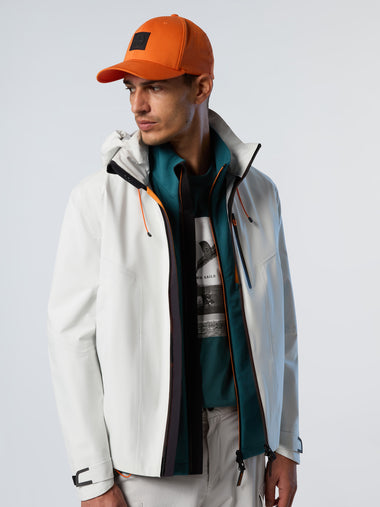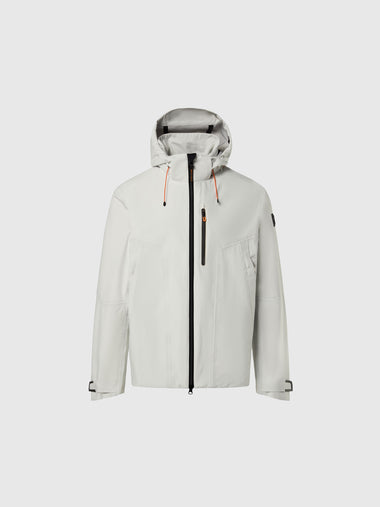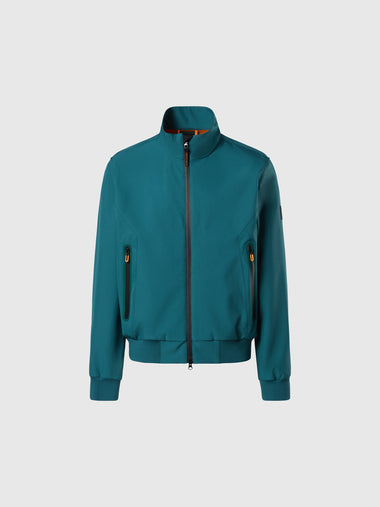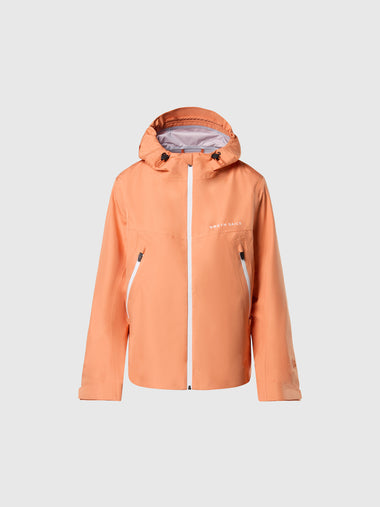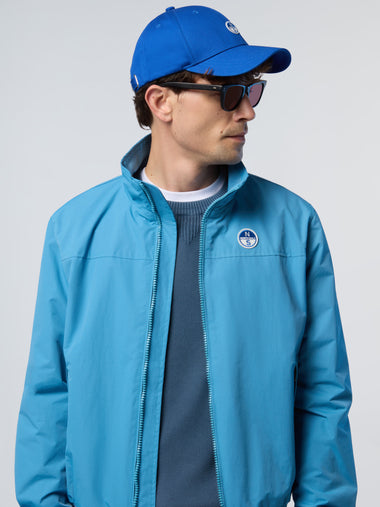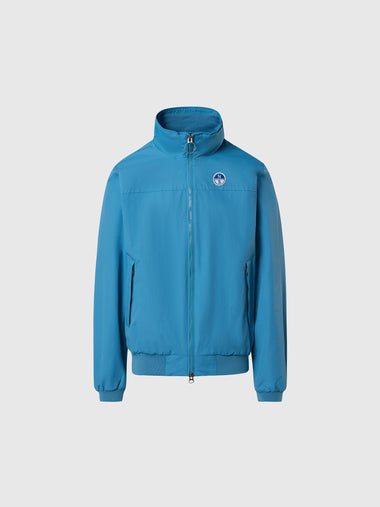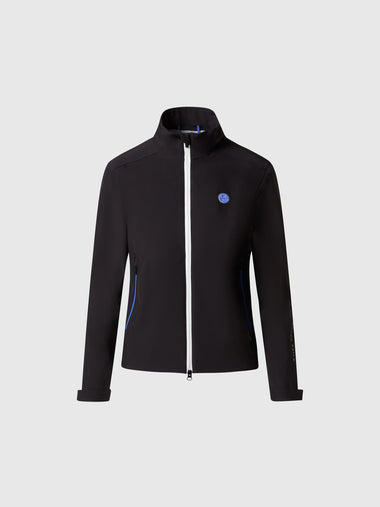E SCOW TUNING GUIDE
This tuning guide is for E Scow sailors using the rig with the chainplates at the max aft position with longer spreaders. With this rig, backstays are not required, allowing the skipper to fully concentrate on tactics and boat speed.
BEFORE STEPPING THE MAST
- Clean and lubricate turnbuckles, make sure that the top and bottom threaded studs are even in the turnbuckle tube.
- Position mast so that base is locked in mast step plate on deck and top end is resting in the boom rest support.
- Check all pins, wires, and fittings for wear, and attach upper and lower shrouds.
- Pull the forestay down along the top of the mast, pull firmly, and mark the wire with a permanent marker at the top of the mast base casting or where the tube is cut off at the bottom. You will use this mark to measure your mast rake once the mast is in the up position.
- Check the spreaders to make sure they are pinned in the forward hole for an all-purpose setting. This puts the spreaders in the aft-most position.
- Make sure that all halyards are pulled down and are not fouled.
- Using the feeder line that comes up through the mast step, tie this onto the bottom end of the jib halyard and pull the jib halyard through the deck. Take care not to loose the feeder line through the deck or you will have to re-run through the pulleys inside the backbone.
- Using a person on the foredeck pulling on the spinnaker halyard and someone walking up the mast, step the mast and attach the forestay.
After stepping the mast, proper shroud tensions should be obtained. If you have a new North mainsail with the slug sewn into the sail, remove the screw holding the slug slide in the mast and remove the slug slide. This slide can be shackled on another sail for use of an older mainsail.
ALL PURPOSE SETTINGS
- For base setting of the mast rake, start by measuring up from the top of the deck at the forestay along the forestay wire to the mark on the wire that corresponds to the mark you put on the wire at the bottom of the mast tube. Please refer to the mast rake chart and use the measurement which corresponds to the year your boat was built.
- At this point, tighten the upper shrouds (shrouds that go to the forestay) so they measure 37 (560 lbs) on a PT-1 Loos tension gauge. Make sure the uppers are in the aft-most hole in the chainplates and also make sure you tighten each turnbuckle the same amount. If you want to really fine-tune the rig, measure down to the deck at the chainplates using the jib halyard and adjust the intermediates to center the mast athwartship.
- Set the lower shrouds at 21 (240 lbs) on the PT-1 gauge and the diamonds at 23 (280 lbs). You will have to work back and forth between shrouds to achieve these base numbers.
Note: If you have a new boat or new shrouds it is important to sail a few times in heavy air to stretch out the rigging before setting permanent marks on the shrouds and the mast rake. Double check the mast rake measurement after tightening shrouds and after sailing in a good breeze.
Rake Setting
The proposed rake settings below are based on the year your E Scow was built.
| 1998 – 2011 | 2012 – 2015 | 2016 or newer |
| 26″ | 26 1/4″ | 26 3/8″ |
Easy Tuning Charts
Note that all recommended turns are from the base settings.
M3 Mainsail / J4 Jib |
||||||
| TWS | 6 knots | BASE – 8 knots (2-3 on rail) |
10 knots | 12 knots | 15 knots | 18+ knots |
| Uppers | – | 37 | +1 | +1.5 | +2 | +3 |
| Lowers | -1 | 21 | +1 | +1 | +2 | +2 |
| Diamonds | -1 | 23 | – | – | +2 | +3 |
| Boards | 2 holes FWD | 1 hole FWD | 1 hole FWD | AP | 1 hole AFT | 2 holes AFT |
| Outhaul | Smooth | Smooth | Smooth | Smooth | Max | Max |
| Vang | Loose | Slack Out | Firm | Firm | Max | Max |
| Cunningham | Loose | Loose | Loose | 12″ Wrinkles | Smooth | Smooth |
| Main Traveler | Up 2-6″ | Center to up 2″ | 1/4 to 1/2 to Post | 1/2 to Post | 3/4 Down or Post | Post |
| Jib Traveler | Max Up | Max Up | Max Up | Down 2″ | Down 3″ | Down 4″ |
| Clewboard | 2nd Hole From Top | 2nd Hole from Top | 2nd Hole From Top | 3rd Hole From Top | Bottom Hole | Bottom Hole |
| Tack Height | 4″ | 4″ | 3.5″ | 3″ | 2.5″ | 2″ |
MAINSAIL TOP BATTEN – 6-12 knots go to 10180c, >12 knots increase to 10230c
2021 Easy Tuning Charts
Jib Tack Height
Jib tack height at base measured from the deck to the bearing point of the jib tack control line. Mark your control line to ensure you can quickly find your base setting. Adjusting the jib tack in in small increments during a race is a quick way to power-up or de-power the jib and has a more meaningful effect on jib shape than a 1 hole adjustment on the clewboard. See below.

Jib Spreader Mark
- 18.5″-19″ measured from center rivet on front of spreader bracket, alongside the front of spreader.
- In most conditions, the jib leech should be at or near this mark. Periodically sight through the mainsail window or from behind the mainsail to check your sheeting is accurate.
RACING YOUR ASYMMETRICAL
We wanted to provide you with some helpful tips so that your learning curve moves upward. Please follow some of these initial tips so that you reach maximum performance right out of the gate. Teamwork is a major factor in this sport. So, work with your team and see what techniques may work for you specifically. The tips provided are a baseline to work from.
When setting up your Asymmetrical sheets – be sure to rig them so that you are doing “inside jibes”. The clew passes between the luff of the kite and the forestay. A quick way to ensure this is to lead the tack line over the starboard spinnaker sheet when you rig your sheets. Tack over sheet.
IMPORTANT MAST TUNING AND ASYMMETRICAL TECHNIQUES TO LEARN
As with any masthead spinnaker configuration, the rig is more loaded and will require more attention to rig tuning and some changes in sailing technique.
DIAMOND STAYS
The diamond stays on the mast help to support the mast head spinnaker configuration and the tension on the diamonds is important to ensure that the mast stays pre-bent and in column. It is important to follow the tuning guide recommendations and not stray too far from these numbers. Diamonds that are too loose when it is windy will not support the masthead kite properly and cause the mast to invert.
Note: Diamond stays will stretch when they are new and you must check them before and after heavy air races, especially when the rig is new. Diamond stays will also measure differently with different tension on the Intermediates and the lowers.
SPREADERS
Spreaders should always be in the maximum aft setting on the mast to ensure maximum spreader sweep. Note: This is the fast setting for all wind conditions, and this is true for the aft chainplate boats as well as the forward chainplate boats.
The upper spreaders are set from the factory with approximately a 6-1/4” sweep when measuring from the back of the mast to a straight line from tip to tip where the wire passes through the tip. Sweeping the spreaders forward will make the top of the mainsail fuller, sweeping them aft will flatten the top of the mainsail.
SIDESTAY TENSION
With the forward chainplate rigs it is important to start to put some tension on the uppers once the breeze is over 10 knots. 400 lbs. On the uppers is necessary to insure that the mast stays prebent when sailing downwind. We recommend sailing with the uppers closer to 600 lbs once the breeze is over 15knots. This is the same for the aft chainplate rigs. With the aft chainplate rigs we rarely go below 600 lbs on the upper sidestay tension.
MAINSHEET TECHNIQUES
It is important with the Asymmetrical to sail at slightly hotter or higher angles than with the symmetrical kites to achieve the greatest performance. This, along with the higher speeds you are achieving will bring the apparent wind angle forward and require the mainsail to be trimmed at a tighter angle. Also, more vang can be carried since you are sailing at hotter angles with more load on the mainsail. Because you are sailing at hotter angles and the A sails are so easy to jibe you should not ease the mainsail out too far on the jibes. The maximum the sheet should ever be eased is about 10’ measuring from the aft corner of the boat to the boom. This technique along with keeping some vang on will help maintain a positive bend in the mast and regardless of backstay tension will help ensure that the mast does not do an inverted bend.
RECIPE FOR MAST DAMAGE
Crew weight should never exceed 675lbs. on an E Scow. The target weight for 4 people sailing in heavy wind is 630-650lbs. Sailing heavier will dramatically increase loads on the boat and rigging and amplifies mistakes made with tuning and mainsail handling.
Jibing in heavy air with the vang loose and the mainsail eased out too far can be a recipe for mast problems. This is the single most important thing you need to concentrate on when sailing the A sail configuration. When you go into a jibe do not slow the boat down, go from high-speed mode right into the jibe. I equate this to a high-speed windsurfing jibe. If the diamonds are too loose and the uppers are too loose this will also compound the situation and cause the mast to invert and could cause failure.
As with any powered-up masthead configuration you have to learn the techniques to ensure that you are safely performing the maneuvers. Once you understand the mechanics of the rig you will realize how much fun the A sails are and how much easier they are to sail. With the proper mechanics of boat handling and rig tuning, the rigs are very durable and will stand up to a lot of wind. It is very important to stay within the recommended rig settings. Do not overload the shroud tension or the crew weight as this places too much compression load on the mast and boat and can cause failures.
Downwind Asymmetrical Techniques
SETTING THE ASYMMETRICAL
- Pull the bow sprit all the way out – Important – You cannot pull the bowsprit out until you break the plane of the windward mark. Only pull bow sprit out prior to hoisting without kite launcher and one pull tack line system.
- Mid crew opens the bag and prepares for the kite to exit the cockpit. Only if you don’t have a kite launcher.
- Make sure to keep the boat flat when in the hoisting process as this helps keep the spinnaker out of the water. Not as important with kite launcher.
- Mid Crew pulls the spinnaker halyard all the way up – Tip – Make a permanent mark on the halyard in the “full up” position so you pull to that point every time.
- With kite launcher on hoist countdown, jib crew pulls windward jib sheet in through ratchet and cleats to windward to clear kite launcher hole.
- After the halyard is ¼ of the way hoisted, Jib Crew now pulls the tack of the asymmetrical all the way out and then immediately uncleats the jib sheet and properly trims jib.
- Helmsperson Tip – on the set it is very important to help your crew out by bearing away a bit on the hoist. This allows the kite to go all the way up with ease. It is important to also make sure the mainsail is not let out too far. The halyard and head of the kite can get hung up behind the spreader delaying the hoist. Keep an eye on these things.
- Once the halyard is up your mid crew should communicate “made”. The helmsperson should freshen (head up) right away so that the kite blows away from the rig and then fills.
- Limit your mistakes on the set – do not sail too high on the set – this makes it harder to pull the halyard up and the kite will fill early making it harder on the crew. With practice, you can push this limit higher.
- Limit your mistakes on the set.
- Practice your timing on all of these things and know when you can push the envelope for the ultimate set!
THINGS TO THINK ABOUT AND PRACTICE
- When sailing downwind with the asymmetrical we sail with our boards all the way down. In varying conditions, you may want to experiment with pulling your boards up some. This could be especially good in moderate winds and wavy conditions. Practice this technique and find out what is fast for your team. When in doubt though – keep the boards all the way down.
- The angle of heel will not vary from the symmetrical kite setup.
- It is very important to keep your lines clean and drop coiled. You need to drop coil your spinnaker sheets after every jibe so that the sheet runs free through this maneuver.
- Compass – it is very important to watch your compass angles downwind while staying in the freshest breeze on the course. These boats will be going very fast. Angles and wind really make the difference. Watch your compass as much if not more than you do going upwind.
- Downwind Sailing Angles – this will vary some. Many think that you have to sail hot and fast in all conditions with this setup. This is not the case. Here is a brief guideline to go by.
WINDS 0 – 8 KNOTS
A higher angle is required so that the boat builds apparent wind. With this speed, you can begin to sail low. As soon as the boat slows even slightly or the boat begins to flatten in angle of heel – you need to head right back up and fire up the speed again. This requires constant attention and focus. One key factor in this condition is mainsheet trim. As your apparent wind moves forward you need to keep your mainsheet trimmed a lot more. Make sure your mainsail is not luffing. You will be amazed as to how the boat reacts to a tighter mainsheet and how much the boat likes to have the mainsheet worked downwind. Practice this. In this wind range, you want to practice float jibes where you bear away slowly and ease the kite out and start pulling it around so it floats around the bow.
WINDS 9-12 KNOT
You can experiment with sailing a lower or deeper angle in these conditions. As the breeze hits and the boat heels, begin to drive the boat down and sail deeper. Work your mainsheet. As you sail deeper the main will need to be eased slightly, but not nearly as far as would for a symmetrical sail.
WINDS 13 – 15 KNOT
This is where it is really fun! Rock and Roll time! Crews should all be on the high side in their hiking straps. The mainsail will need to be trimmed in – almost all the way at times – as your apparent wind is way forward. The Jib Crew will need to work the jib and also the vang. It will feel like you are sailing at a higher angle due to the speed build-up. You really need to get the boat up and rolling – do not sail low or keep people in the boat – put them on the rail and go for a fast ride! The key is the mainsheet, keep the main trimmed. Do not ease the main much through your jibe either! Keep the sail in! In this wind condition you want to perform Mexican jibes, the skipper turns right into the jibe, you trim the sheet tight, strap the foot of the kite, let it back slightly onto the rig on the new windward side of the boat and as the main is coming across you blow the sheet off and trim the new sheet on quickly.
ASYMMETRICAL TAKEDOWNS
The easiest takedowns are the Windward takedown or the Mexican take-down. The leeward takedown is your third option.
WINDWARD TAKEDOWN
- Head the boat virtually dead downwind.
- Middle crew begins to pull the windward spin sheet around and then the Jib crew releases the tack line shortly after that. You can release the bow sprit line shortly after. With the kite launcher, mid crew counts down 3-2-1 as they start to pull on the kite retrieval line, jib crew uncleats halyard on 0 and then tack line, tailing as they drop to keep the kite out of trouble. All sheets have to run smoothly to keep the kite coming in freely.
- Middle Crew – Pull the windward sheet aggressively through the ratchet – all the way back so that the clew reaches the ratchet block. The sail will have inverted. Only if you have no kite launcher.
- Middle Crew – Call for the halyard once you have the sail in hand. See #2 for kite launcher.
- Helmsperson – Before the halyard begins to drop be sure to steer up slightly so that the sail blows onto the deck of the boat. If you are dead downwind or sailing by the lee the kite will blow out away from the boat and go into the water. This is not good. It is very important that the helmsperson helps out the crew by steering up.
- The Middle Crew stuffs the sail into the bag and prepares for the rounding. Only if you don’t have a kite launcher.
MEXICAN TAKEDOWN
This takedown is effective when approaching the leeward mark on starboard tack and you need to jibe to go around the mark. As you reach a 3 boat length circle from the leeward mark you prepare to go into action. The key is that you need to be at about 150 degrees to true wind as you complete your jibe and you sail on port tack to the mark ( as you jibe you need to have the ability to head up on port jibe slightly so that the asymmetrical stays on the deck of the boat. If you come out of the jibe dead downwind the spinnaker will fall right into the water – again, the helmsperson needs to do their job to make the takedown easy and effective). So, your relation to the leeward mark is critical – you want to exit the jibe and begin to reach toward the leeward mark.
- You enter the three boat length circle on starboard tack.
- Helmsperson calls for a Mexican.
- Middle Crew – Be sure to drop the windward board before entering the jibe.
- Begin the jibe – the Middle Crew needs to trim the sheet hard so that the clew goes to the ratchet on the port side of the boat. This brings the clew and the foot of the sail to within reach for the takedown.
- The helmsperson turns the boat and enters the jibe. As the boom goes across he yells for the halyard release. The Jib Crew needs to release the halyard and the mid crew will already be taking in the retrieval line.
- The helmsperson needs to head up so that the sail gets “pressed” into the rig on the port side. The key is to head up so that the sail falls onto the deck and into the rig keeping the sail away from the water.
- The crew needs to be on the high side – on this port jibe as you approach the leeward mark – very important if it is windy as the boat will accelerate once you begin to reach to the mark.
- The tack line and bowsprit line are the last two items to be released. The Middle Crew needs to stuff the sail into the bag and hike hard as the boat rounds the mark. Refer to #2 on windward takedown for jib crew steps.
- Middle or jib crew pulls the board up on the port side as soon as possible or before the leeward mark.
LEEWARD TAKEDOWN
- The key here is that the helmsman heads down for an easy takedown.
- Release the tack line and trim the spinnaker sheet in.
- Release the halyard slowly or with friction for the first 8 feet so that the halyard does not blow out and get hooked on the leech of the mainsail.
- Middle Crew stuffs the kite into the bag.
- Final release is the bowsprit line which can occur shortly after the release of the tack line.
- Takedown with kite launcher: Helm bears away, mid crew starts retrieval in counting down, 3-2-1 halyard is released, then tack. Flatten boat as much as possible to all crew to windward. Speed on the retrieval line is the name of the game.
SET UP
It is important to follow the North Sails Tuning Guide – I-1 Rig. Follow the amount of rig tension suggested for the varying conditions.
SPECIAL CONSIDERATIONS
The angle of heel is very important on an E Scow. Upwind in up to 10 knots, go for a maximum heel, but never let the water get up on the leeward deck. In more wind, sail with the bilge board vertical in the water. Don’t let the boat heel too much when sailing in a chop: it might feel good, but it is not fast. Just make sure that the bilge board is vertical, or that the boat is just a little flatter. When sailing in a lot of chop, be sure to have a very full jib, power up the main by keeping the rake forward, Cunningham off all the way and the outhaul pulled just until the vertical wrinkles disappear.
An E Scow travels at very high speeds for a sailboat, and is very maneuverable even though the rudders are only 10” X 16”. Still, it is important for the crew to be in tune with the skipper to help steer the boat. When a big puff hits, the bow has a tendency to blow to leeward, so the jib crew must be prepared to ease the sheet to prevent this. The most important thing to do when tacking an E Scow is to lower the new board at the right time. As the boat is turning through the tack, wait until the bow is just past head to wind to lower the board: if you do this too soon, it just creates extra drag and slows the boat down. Don’t worry about raising the windward board until the boat is up to speed on the new tack. We like to ease the main slightly and then trim it in to heel the boat as we come up into the wind, and then everybody rolls the boat together. In light to medium winds, keep the jib trimmed in until the boat is head to wind and let the windbreak it across. When it starts to get windy it isn’t necessary to roll the boat, but ease the jib sooner so the bow can come up into the wind easier.
TACTICAL CONSIDERATIONS
As far as tactical considerations go, at the start just remember that E Scows accelerate quickly, so it’s important to trim in before the boats around you or you might get rolled right away. If you have the room to leeward, simply put the boat on a tight reach with 15 seconds to go, get it up to speed by the time you hit the line, and make sure you can sail over the boat to leeward. E Scows don’t seem to create much of a wind shadow, so don’t be afraid to sail in someone’s bad air if you think it’s the right way to go, since the gains in a windshift can outweigh the loss of boat speed. These boats sail so fast that you are never out of the race. If you find yourself behind, several good wind shifts can move you right through the fleet. The important thing to remember is to keep the pedal down and never give up.
All these generalizations are norms and averages that have proven fast over many years. Some experimentation on your part may be necessary to fine-tune your particular rig and sailing style. Good luck!






